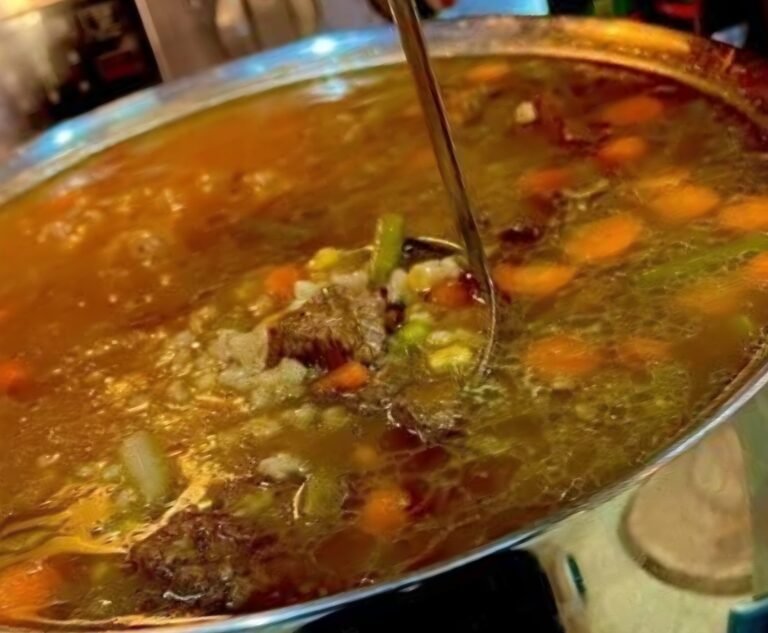Hearty Mulligan Stew: A Comforting One-Pot Classic

Mulligan Stew is the epitome of rustic comfort food—a soul-warming dish born from resourcefulness and creativity. This hearty, one-pot meal has roots in early 20th-century America, where resourceful cooks, often in hobo camps or rural kitchens, threw together whatever ingredients were on hand to create a nourishing stew. The beauty of Mulligan Stew lies in its versatility and simplicity, making it perfect for cozy family dinners, chilly evenings, or gatherings with friends. Our version of this timeless dish features tender beef, vibrant vegetables, and a rich, savory broth infused with aromatic thyme. Paired with a slice of crusty bread, this stew is guaranteed to warm both body and soul.
This recipe serves 4–6 and takes about 2 hours to prepare, but the hands-on time is minimal, allowing the stew to simmer and develop its deep flavors. Whether you’re a seasoned home cook or a beginner, this Mulligan Stew is approachable, forgiving, and endlessly adaptable to your pantry staples. Let’s dive into how to make this wholesome dish!
Ingredients
To create a robust and flavorful Mulligan Stew, gather the following ingredients. Feel free to adjust quantities based on your preferences or what you have available—this stew is all about making do with what’s on hand!
- 1 pound beef stew meat, cut into bite-sized cubes (chuck roast or bottom round works wonderfully for tender, melt-in-your-mouth results)
- 3 cups potatoes, peeled and diced into 1-inch chunks (Yukon Gold or russet potatoes hold their shape well)
- 2 medium carrots, peeled and sliced into rounds or half-moons for a rustic look
- 2 celery stalks, chopped into small pieces for a subtle crunch
- 1 large onion, diced (yellow or white onions add a sweet, savory depth)
- 3 cups beef broth, preferably low-sodium to control the saltiness
- 1 (14-ounce) can diced tomatoes, with their juices for a tangy, rich base
- 1 teaspoon kosher salt, or to taste
- ½ teaspoon freshly ground black pepper, for a mild kick
- 1 teaspoon dried thyme, for an earthy, herbaceous note (or substitute with 1 tablespoon fresh thyme)
- 2 tablespoons olive oil or vegetable oil, for browning the beef
- Optional: 1–2 cloves garlic, minced, for extra flavor
- Optional: 1 cup frozen peas or green beans, added near the end for a pop of color and sweetness
Equipment Needed
- Large, heavy-bottomed pot or Dutch oven (a 5-quart pot is ideal)
- Wooden spoon or spatula
- Cutting board and sharp knife
- Measuring cups and spoons
- Ladle for serving
Instructions
- Brown the Beef for Maximum Flavor
Heat 2 tablespoons of olive oil in a large pot or Dutch oven over medium-high heat. Pat the beef cubes dry with paper towels—this helps achieve a nice sear. Add the beef to the hot oil in a single layer, working in batches if necessary to avoid overcrowding. Brown the meat on all sides, about 5–7 minutes per batch. The caramelized crust adds incredible depth to the stew, so don’t rush this step! Once browned, transfer the beef to a plate and set aside. - Sauté the Aromatics
In the same pot, add the diced onion, carrots, and celery. If using garlic, add it here as well. Cook, stirring occasionally, for 5–7 minutes until the vegetables soften and the onions turn translucent. The vegetables will absorb the flavorful browned bits from the beef, enhancing the stew’s richness. - Combine the Ingredients
Return the browned beef to the pot. Add the diced potatoes, beef broth, canned diced tomatoes (with their juices), salt, pepper, and dried thyme. Stir everything together to ensure the ingredients are well combined. The broth and tomato juices create a savory, slightly tangy base that ties the dish together. - Simmer to Perfection
Bring the mixture to a gentle boil over medium-high heat. Once boiling, reduce the heat to low, cover the pot, and let the stew simmer for 1.5 to 2 hours. Stir occasionally to prevent sticking. The long, slow simmer allows the beef to become fork-tender and the vegetables to meld into a cohesive, hearty dish. If the stew thickens too much, add a splash of additional broth or water to reach your desired consistency. - Optional Additions
If you’re using peas or green beans, stir them in during the last 10 minutes of cooking to preserve their vibrant color and texture. Taste the stew and adjust seasoning with additional salt or pepper if needed. - Serve and Enjoy
Ladle the steaming-hot Mulligan Stew into bowls and serve with a side of crusty artisan bread, dinner rolls, or cornbread to soak up the flavorful broth. For an extra touch, garnish with a sprinkle of fresh parsley or a dollop of sour cream for creaminess.
Tips for the Perfect Mulligan Stew
- Make It Your Own: Mulligan Stew is famously flexible. Swap the beef for chicken, pork, or even lentils for a vegetarian version. Add other vegetables like parsnips, turnips, or mushrooms based on what’s in season or in your fridge.
- Thicken the Broth: For a thicker stew, mash a few potato pieces against the side of the pot or stir in a slurry of 1 tablespoon cornstarch mixed with 2 tablespoons cold water during the last 10 minutes of cooking.
- Slow Cooker Option: Brown the beef and sauté the vegetables as directed, then transfer everything to a slow cooker. Cook on low for 6–8 hours or on high for 3–4 hours for a hands-off approach.
- Make Ahead: This stew tastes even better the next day as the flavors meld. Store leftovers in an airtight container in the refrigerator for up to 3 days or freeze for up to 3 months.
Why You’ll Love This Recipe
Mulligan Stew is more than just a meal—it’s a celebration of simplicity and resourcefulness. Its humble ingredients transform into a dish that’s greater than the sum of its parts, offering warmth and comfort in every spoonful. Whether you’re cooking for a crowd or meal-prepping for the week, this stew is a budget-friendly, crowd-pleasing option that’s as satisfying to make as it is to eat.
Serving Suggestions
- Pair with Bread: Serve with a rustic loaf, garlic bread, or homemade biscuits to mop up the broth.
- Add a Side Salad: A crisp green salad with a tangy vinaigrette balances the stew’s richness.
- Beverage Pairings: Enjoy with a glass of red wine (like a Cabernet Sauvignon) or a cold, crisp cider for a cozy meal.
Nutritional Information (Per Serving, Approximate)
- Calories: 350–400 kcal
- Protein: 25g
- Fat: 12g
- Carbohydrates: 35g
- Fiber: 5g
Note: Nutritional values vary based on portion size and specific ingredients used.
A Brief History of Mulligan Stew
The origins of Mulligan Stew are tied to American ingenuity, particularly during the Great Depression when communities made do with whatever ingredients were available. Often associated with transient workers or “hoboes,” the stew was a communal effort, with each person contributing an ingredient to the pot. The name “Mulligan” may come from Irish immigrants or a slang term for a second chance, reflecting the dish’s forgiving nature. Today, it remains a beloved comfort food, cherished for its adaptability and heartiness.





